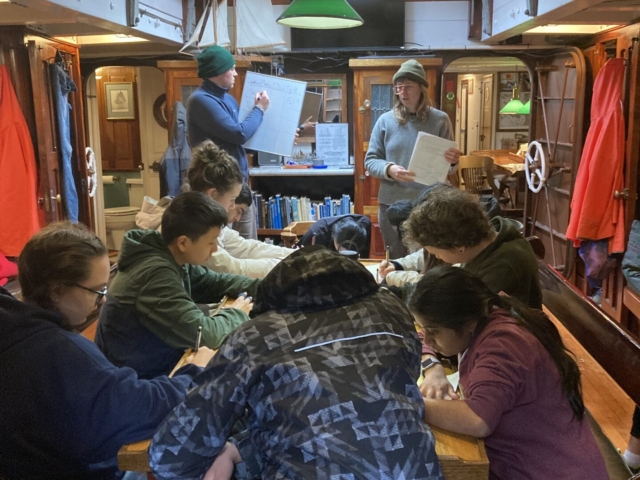By Dustin Vail, Salish Sea Expeditions Operations Coordinator
Salish Sea Expeditions’ spring programming has officially lowered sail for the season… but what an incredible season it was! From March to June of this year, 572 students and 95 teachers joined us aboard our program vessels—Admiral Jack and the Schooner Zodiac. This combined effort resulted in 19,406 hours spent outside making deep connections.
On Admiral Jack, students and teachers spent a total of 13 days exploring the interconnected aquatic environments of the Duwamish River and Elliot Bay. During their marine pursuits, participants used plankton nets, Niskin bottles, secchi disks, microscopes, and charts to investigate scientific inquiries. This season we added a drop camera aboard Admiral Jack, courtesy of the Washington Department of Fish and Wildlife. This addition allowed students to visually venture below the surface and further explore the marine environment. Guided by our amazing staff, students were able to easily view the submarine scenes captured by the drop camera, as the images were live-streamed to the large monitors aboard the vessel. Equipped with curiosity and ID cards, students identified, counted, and discussed the importance of each species they saw.
Aboard the Schooner Zodiac, we welcomed 10 school groups and one adventurous team of teachers who took part in an onboard teacher training. Groups this season collectively spent a total of 41 days circumnavigating the San Juan Islands. During each journey, students collected, tested, and interpreted water quality and plankton samples, built onboard STEAM projects, explored the briny deep through the lens of an ROV, zipped ashore to explore the Islands, and ate perhaps the best food ever to be served aboard a ship. While students tacked, (control) jibed, and maneuvered their way through the Islands, they were greeted by an abundance of marine mammals. Aside from the ever-present and always exciting harbor seals, participants spotted over 20 orcas, 3 minke whales, 2 gray whales, and multiple superpods of harbor porpoise. In addition, one group even witnessed a stowaway otter that took it upon itself to climb into an inflatable and enjoy a plentiful Dungeness crab dinner. At the end of each trip, during the closing circle, students and teachers were asked to share both a trip highlight and something they will not soon forget. Here are some common answers: learning to sail; mastering their sailing station; steering the ship; raising the largest mainsail on the West Coast of North America with their classmates; bow watch; boat races; sweating/tailing; laying on the bowsprit while putting away the jib; the hikes on James, Sucia, and Stuart Island; taking plankton samples; building light traps; playing games like “fish bowl” and “scuttle hatch;” spending time on a boat laughing with their friends; seeing orcas; and of course…. the food! We had an unforgettable and very successful spring season, the joy, bonding, and growth that took place is hard to fathom and near impossible to put into words.
There are many thanks to be given to those who made this season possible. First, we harbor the utmost gratitude for the crew of the Schooner Zodiac. Thank you so much for all that you did to make this spring season one that each participant will remember for a lifetime. Our programmatic sails truly fill with pride when reflecting upon and looking forward to the partnership we have formed. Enormous and resounding thank you to both crews of the Salish Sea Expeditions team! Thank you for all your hard work, dedication, and commitment to changing students’ and teachers’ lives out at sea. Finally thank you to all the participants, students, and teachers who decided to come join us! We can’t wait to see you all again next season.
…
Learn more about Salish Sea Expeditions and request a program for your school or group on our webpage.













